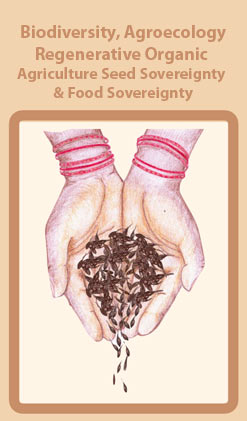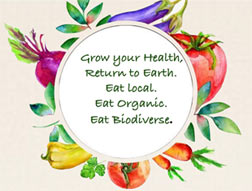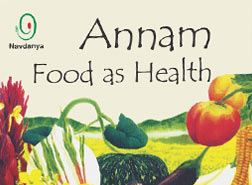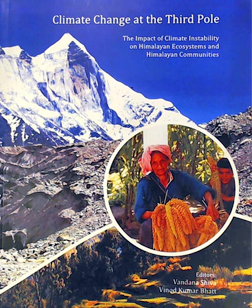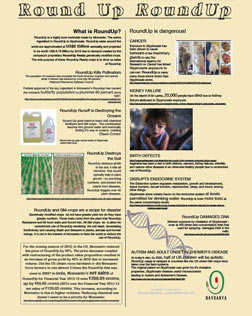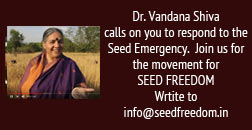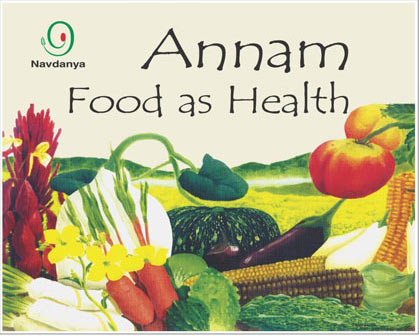 The book creates awareness on healthy eating so that disease & hunger burdened in the Indian people is removed an India emerges as a strong nation based on Biodiversity organic farming a healthy people.
The book creates awareness on healthy eating so that disease & hunger burdened in the Indian people is removed an India emerges as a strong nation based on Biodiversity organic farming a healthy people.
The contributors of the book, all eminent expert from their field will be creating a think tank on the linkages between food agriculture and health and task force to inform would the general public and the policy makers.
To order This email address is being protected from spambots. You need JavaScript enabled to view it.
ANNAM Executive Summary
India is emerging as an epicentre of major non communicable chronic diseases .Annam:Food as Health ,is a book published by Navdanya , the movement for biodiversity in agriculture and in our diet .Annam is written by experts from diverse backgrounds to address this public health emergency , and offer solutions with the backing of the most sophisticated knowledgeand practice .The contributors include ecologists, agroecologists and biodiversity experts , doctors with Ayurveda and allopathic backgrounds , and those practising integrative medicine .
Annam Food as Health
Contributors:
- Foreword by Hon'ble Dr J.P. Nadda, Minister of Health and Family Welfare, Government ofIndia,
- Dr. Vandana Shiva, Founder Navdanya
- Prof. Dr. G. G. Gangadharan, Ayurvedacharya, & Director, Ramaiah Indic Specialty Ayurveda, ∙
- Prof. Dr Rama Jayasundar, Department of NMR & MRI Facility, All India Institute of Medical Sciences, New Delhi, ∙
- Prof. Dr. Bhushan Patwardhan Director, Center for Complementary and Integrative Health (CCIH), Savitribai Phule University, Pune ∙
- Dr. Mira Shiva, Coordinator Initiative for Health & Equity in Society, Founding member Doctors for Food Safety & Biosafety, ∙
- Maya Goburdhun, Director Navdanya.
The rapid spread of chronic diseases is related to changes in our diets and changes in the way we grow food . The spread of toxics and monocultures in farming have produced nutritionally empty food loaded with poisons . In addition , there is an invasion of industrially , chemically processed food and junk food with heavy advertising ,as well as an invasion of an obsolete , mechanistic , reductionist paradigm of science which ignores the latest in the sciences of ecology , of food of health . It treats bad food as “substantially “equal to good food based on reductionist criteria which ignore processes and impacts on our health .The Health Minister of India Dr J P Nadda has written the forward to the book , and welcomed the timely contribution that brings cutting edge science , combined with our ancient Science of Life, Ayurveda , to the people to help them make healthy food choices . Dr Vandana Shiva , trained as a quantum physicist, and practitioner of ecological science fir more than 4 decades shows how health is a continuum from the soil , to the plants, to our bodies. Chemical farming is based on monocultures , which deprive us of the diversity we need for a balanced, healthy ,nutrition. Chemical farming depletes the soils of nutrition, producing plants that are nutritionally empty but full of toxic residues . When we eat chemically produced food we suffer from diseases related to nutrient deficiency and/or toxics.
Dr Gangadharan reminds us that in Ayurveda food is medicine ,”Sarvaushadhi” ,and seasonality , and methods of production and preparation are vital to health . Ayurveda identified the digestive system as the most important to health .
- Samagnischa: Agni (internal digestion/ metabolism which includes 13 types of agnis, digestive, met- abolic and transformation processes) should be balanced.
Western science is finally waking up to this reality.
As the book “Mind Gut acknowledges “ For decades the mechanistic , militaristic disease model set the agenda for medical research . As long as you could fix the affected mechanical part, we thought the problem would be solved :there was no need to understand its ultimate cause ….We are just beginning to to realise that the gut , the microbes living in it -the gut micro biota the microbiome-constitute one of the major components of these regulatory systems and the signalling molecules that they produce from their vast number of genes “ (pg 6 Mind Gut )
Dr Rama Jayasundar , a biophysicist who heads the NRM unit at AAIMS , as well as an Ayurvedicexpert ,points out that the reductionist mechanist concept is in adequate to understand thecomplexity of the human body “The human body is a complex biological system with many structures, biochemicals, functions, and a range of activities like electrical and magnetic, thus providing a wide scope for different viewpoints. While the modern biological and medical model is structure oriented, Ayurveda has a functional perspective of the human body [14]. Functions are a result of complex interactions between a large number of factors rang- ing from structures to biochemicals. A functional perspective, therefore, will be an inclusive and systemic one, taking into consideration all these contributing factors.”
Dr Mira Shiva , one of the leading public health experts of India with an MD in internal medicine gives us a wake up call on the food and health emergency facing the country.
“India ranks 55th out of 76 on the Global Hunger Index and is home to nearly 194.6 million under nourished people. Approximately 15.2% of India is undernourished, nearly 73% of households do not have access to sufficient food or health. Nearly 12 out of 29 states fall in ‘alarming’ category. India is a signatory to the Sustainable Development Goal (SDG) .Goal No.2 (SDG 2015-2030) is toeradicate hunger.
The 1st two targets of this goal are: .
2.1. By 2030 end hunger and ensure access by all people, in particular the Poor and people in vulnerable situations, including infants to safe Nutritious and sufficient food all year round. .
2.2. By 2030, end all forms of malnutrition including achieving, by 2025, the inter- nationally agreed targets on stunting and wasting in children under five years of age, and address the nutritional needs of adolescent girls, pregnant and lactating women and older persons.
We have two options to address the health emergency of hunger and disease . Continue on the reductionist mechanistic path , making the crisis worse , or take the road of biodiversity , Agroecology, Ayurveda.
Einstein had said that you cannot solve the problems with the same mind set that caused them.
Dr Bhushan Patwardhan stresses that food supplements cannot solve the problem of deficient and degraded diets .
“At present, there is increased global awareness about the importance of eating natural, and fresh foods, rather than consuming processed foods. There is growing evidence to support the importance of fresh, and natural foods. For instance, to counter vitamin A deficiency, eating fresh carrots is better than taking carotenoid supplementation. Fresh fruits like papaya, and vegetables like carrots, are much better toler- ated, and have been shown to improve vitamin A status in lactating mothers. Just consuming proximate principles like proteins, carbohydrates, and fats is notenough for healthy growth and sustenance.
” Dr Vandana Shiva through a scientific analysis shows how fortification and biofortification experiments such as Golden Rice and GMO banana will offer cure the diseases caused by industrial chemical monoculture farming.
The Food Safety and Standards Authority of India has adopted Food Fortification as a priority with the slogans - “Fighting Malnutrition, Improving Lives”. The Logo is “+F Sampoorna Poshan SwasthJeevan”.
However, adding one nutrient to nutritionally empty food cannot overcome the diverse nutrient de- ficiencies created in agriculture through the NPK (Nitrogen, Phosphorous and Potassium) mentalityand monocultures. Nor can it compensate for food deprivation because of the hunger and malnutrition designed into the industrial food paradigm (Vandana Shiva, Who really feeds the World, and Hunger by Design in Making Peace with the Earth).
Finally Maya Goburdhun , the Director of Navdanya , shares with the readers the experience of Navdanya’s conservation and rejuvenation of the rich diversity of foods we can grow and have on our thali.
As she writes “In this presentation of what Mother earth has made available to us to nourish us, wehave just touched upon some of the treasures; there are many more, hidden within communities ordistant climes. With such a cornucopia at our disposal it seems myopic to just reduce our food basket to the super market trolley. Navdanya has many programmes, from food literacy to gardening to help those who want to reconnect to Living and Wholesome Foods. You too can be part of the Living Food Movement and heal both your body and the planet.”


